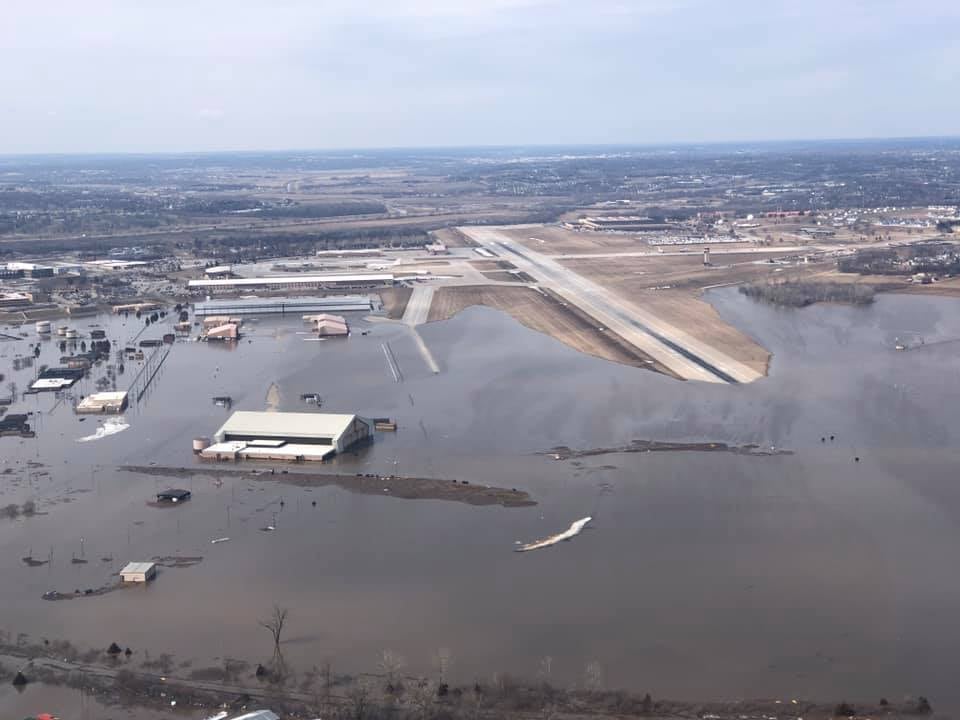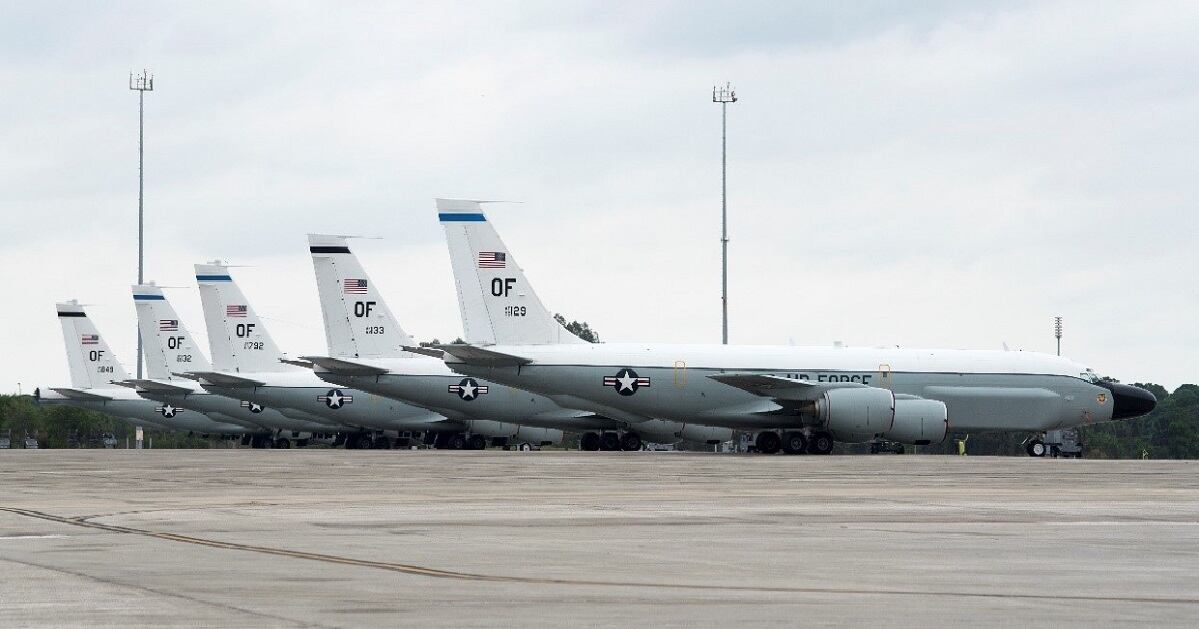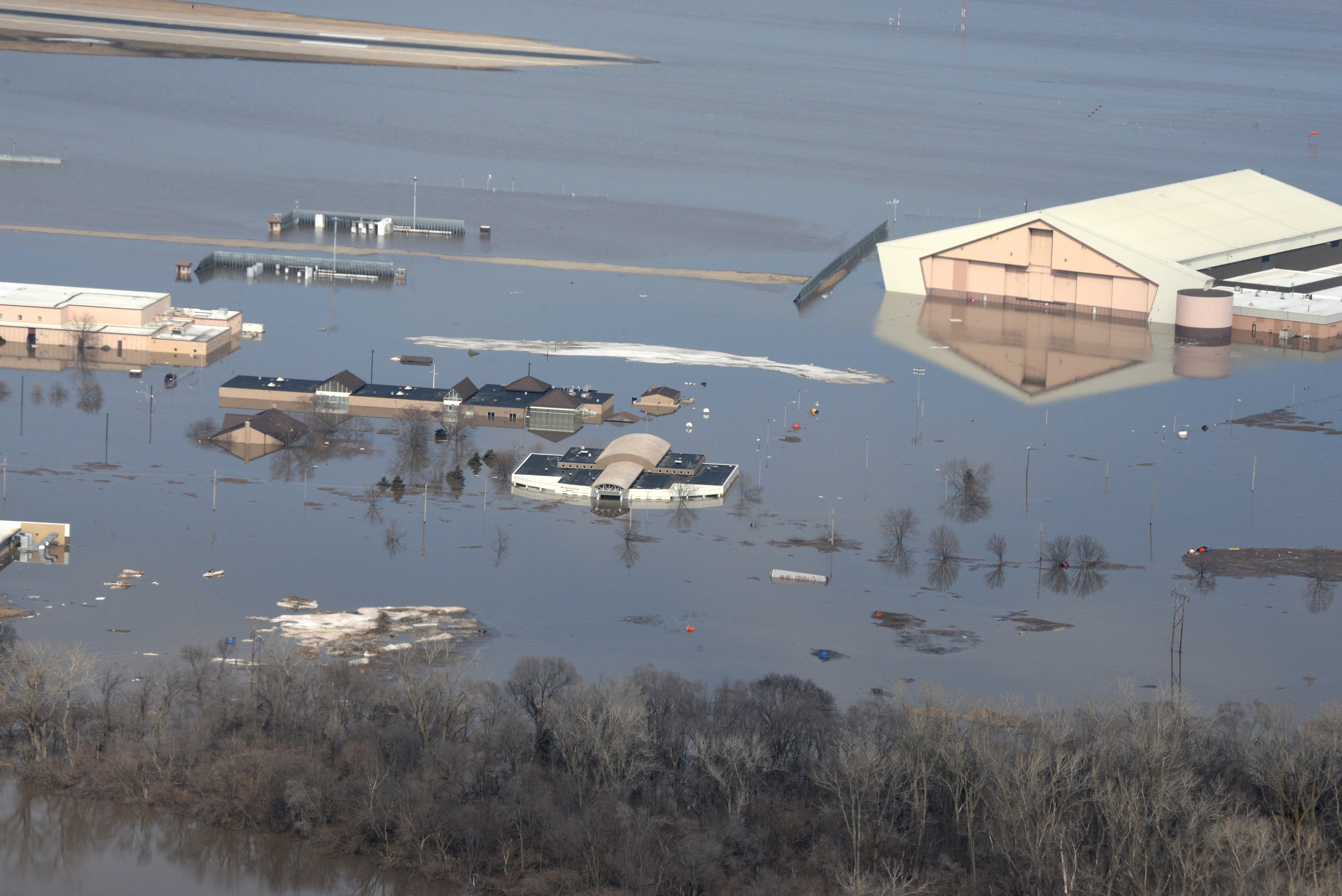In March 2019, the waters of the Missouri River engulfed dozens of buildings and more than half a mile of runway at Offutt Air Force Base in Nebraska, forced nine aircraft to evacuate and displaced thousands of personnel.
But nearly a year and a half later, Offutt is well on the road to recovery from these devastating floods.
And in some ways, according to the officer overseeing the rebuilding effort, the flood has had a “silver lining,” allowing Offutt to rebuild in a better, more thoughtful way for the missions of its future.
“This gives us an opportunity to foundationally rebuild the base for the Air Force’s next generation of warfighting,” said Lt. Col. Christopher Conover, director of the program management office in charge of rebuilding Offutt, in a July 24 interview.
Flooding began to overwhelm Offutt on March 15, 2019, forcing the base to evacuate nine aircraft. About 700 airmen filled 235,000 sandbags in a valiant, but ultimately unsuccessful, effort to hold the waters back. About one-third of the base, including 3,000 feet of runway, was flooded by 720 million gallons of water infested with raw sewage.
About 3,200 personnel were driven out of their workspaces. Those service members and employees are still in temporary workspaces — primarily the 80-year-old Glenn L. Martin-Nebraska Bomber Plant, which produced B-29s during World War II, including the Enola Gay and Bockscar bombers that dropped the atomic bombs on Japan.
Ultimately, 137 facilities — everything from full-fledged buildings to structures as small as generators, hydrants or guard houses — were damaged in the flood. About 60 buildings were deemed unsalvageable and slated for destruction. About 1.2 million square feet of work space — including 118,000 square feet of SCIF, or secure, compartmented information facilities, space for handling highly classified material — was destroyed.
The base’s reconstruction effort — which the Air Force said would cost $420 million, plus another $234 million to replace three destroyed simulators — will likely not be done for six more years.
But, Conover said, work is already well under way — and the base is taking the opportunity to rethink how Offutt is structured and find more efficient ways to do business.
As Offutt plans its reconstruction, it’s aiming for a much more well-thought-out layout, Conover said. The base is planning eight campuses, with 26 new facilities, that will group similar missions together: most importantly, nuclear command and control alert forces, but also satellite communications; multi-domain operations supporting signals intelligence missions; security forces; logistics; flightline operations. including fuels, liquid oxygen and maintenance; and the base lake recreation facilities.

Another campus will handle an emergency power micro-grid, with three interconnected power stations across the base, to provide backup power to critical facilities during power outages. Conover said this is crucial, because all of Offutt’s backup generators were destroyed in the flood.
Offutt began planning these new campuses seven months after the flood. The base has now finished the planning phase, and has moved on to the design phase. Logistics is the easiest to design — using practically an off-the-shelf plan — and is the furthest along, he said.
But others will be more complex and take longer. The multi-domain operations campus, for example, will start being designed this October and will likely take an entire year to finish. Construction on the multi-domain campus is expected to begin in January 2022, and finish in July 2026, he said.
RELATED

The earliest any construction will begin will be around April 2021, after the demolition and fill dirt and utility work is done, Conover said. The environmental assessments required before demolition can begin are expected to be finished this September.
But Offutt’s mission had to go on, flood or no flood, and it needed to find space for 3,200 displaced personnel.
The Martin bomber plant, also known as Building D, had office space that hadn’t been used for more than a decade. So Offutt renovated some of that building’s space, and started putting the bulk of the 3,200 people there.
However, that’s just a stopgap solution, not a long-term answer, Conover said. As Offutt has methodically worked through the flood-damaged hangars and offices to refurbish them, it has moved people back, bit by bit.
For example, people have gradually been moving back into the Bennie L. Davis Maintenance Facility, which is the main maintenance hub for Offutt’s RC-135 fleet. Conover hopes the Davis building will be finished by the end of the year.
Offutt is also preparing for the next floods. The Army Corps of Engineers has repaired all the levees that were breached or damaged by last year’s flood, Conover said. And in April, the base began working on raising the levees to the 100-year flood level, or three feet, he said. That $35 million effort — which was originally scheduled to begin last year, a few weeks after the flood struck — should be finished by December, he said.
Work is also under way to line the Missouri River, as well as the Platte River that serves as its tributary, Conover said.

Congress ordered Offutt to build its new facilities above the 100-year floodplain. That will mean trucking in 673,000 cubic yards of fill dirt to bring the new mission-critical facilities up three feet above the 100-year flood level, and non-mission critical facilities two feet above that level.
But Offutt is not expecting a repeat of the massive, unprecedented flooding, which was caused by a a combination of unique conditions, Conover said. Record snow and low temperatures, which froze the ground, rivers and tributaries, quickly gave way to rising temperatures and then a “bomb cyclone” struck, dumping up to eight inches of rain in the region.
“We feel that there were very specific climatic variables that uniquely aligned that caused this 500-year flood,” Conover said. “So a lot of people are worried about flooding [on that scale again]. We’re not.”
Offutt is also working to restore buildings that were flooded, but not so badly damaged that they couldn’t be saved. Contractors are now working to gut and dry salvageable facilities such as some flooded hangars and Tennant Hall — an eight-year-old building that formerly housed the 97th Intelligence Squadron and served as a SCIF.
Congress gave Offutt permission to keep the relatively new building. But because Tennant Hall sits in the flood plain and can’t be raised, the base will make its first floor “sacrificial” and accept that it will be flooded from time to time. However, this means it will no longer be able to be a SCIF.
The contractors are putting in new walls and utilities to allow Tennant Hall to take on its new missions, including the WC-135 Constant Phoenix nuke sniffer program and anti-drug efforts, as well as warehouse space.
Offutt’s runway was given the all-clear after the waters covering 3,000 feet of flightline receded, without causing major damage. But, Conover said, it is still the oldest runway in the Air Force, and already had plenty of problems.
So the base is preparing to shut the runway down, tear it out completely, and replace it, Conover said. Offutt will move its mission operations to Lincoln, Nebraska, while the runway is redone. This was already in the works before the flood happened, he said.
Three RC-135 Rivet Joint simulators — which recreate the entire interior of those signals intelligence aircraft — were also lost in the flood, with a price tag of $234 million.
The Air Force’s program manager running the simulators, Big Safari, salvaged and repurposed what they could from the flood wreckage, but most of it was shot. So Offutt cobbled together one working simulator out of spare parts scrounged from the depot in Texas and forward operating locations worldwide, as well as U.K. partners.
But while that “band-aid solution” worked to get operations back up and running, Conover said, it’s not ideal. Big Safari is designing and building the next generation of simulators, which could start being installed next spring.
Stephen Losey is the air warfare reporter for Defense News. He previously covered leadership and personnel issues at Air Force Times, and the Pentagon, special operations and air warfare at Military.com. He has traveled to the Middle East to cover U.S. Air Force operations.





